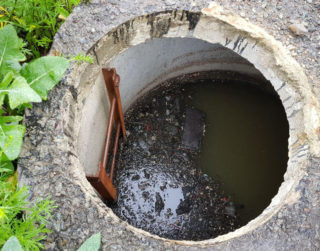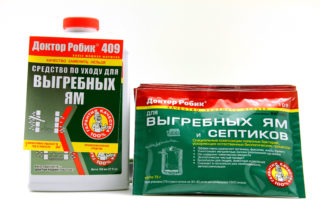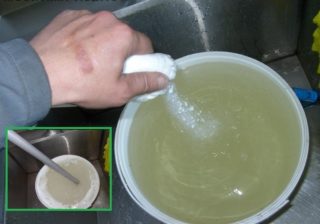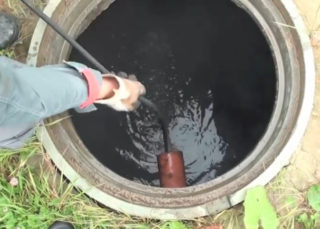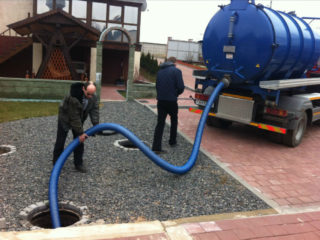For the drainage and disposal of household wastewater in a private house or at a summer cottage, the simplest sewage systems are built - cesspools. The construction of such a treatment plant does not take much time and does not require large expenditures. But over time, the cesspool capacity fills up and needs to be cleaned. There are methods for cleaning a cesspool without pumping out.
When to clean the pit
- an unpleasant smell appeared;
- drainage of water from sinks, sinks, toilet bowl became slower;
- midges and flies appeared in the area of the cesspools;
- filling with drains 2/3 pits.
It is necessary to carry out cleaning systematically, at least once a year.
Cleaning methods without pumping
There are 2 methods for cleaning a cesspool without pumping out:
- Biological.
- Chemical.
Biological treatment is a safe way to get rid of sludge, hard feces and fat. After the waste is processed by artificially grown bacteria, the contents turn into a harmless liquid and the unpleasant odor disappears. Biological products are not harmful to human health and the environment.
- Septic tanks. Decompose waste and improve the drainage layer.
- Antiseptics. They disinfect cesspools, process solid waste into compost and prevent the development of pathogenic microbes and pathogens of invasive diseases. The compost can be used for agricultural purposes.
Bacterial agents are divided into:
- aerobic;
- anaerobic;
- activators.
Aerobic bacteria use oxygen to develop. Anaerobic bacteria do not need oxygen and are even destructive, so they are used in sealed containers. The recycled liquid can be used to water the plants.
Bioactivators additionally contain enzymes. May include aerobic and anaerobic bacteria. They are used both independently and to revive bacteria after cold weather.
Beneficial microorganisms are sensitive to ambient temperature. For development and life, a high temperature is required, but not more than + 30 ℃. In winter and autumn, bacteria do not die, but they stop multiplying. The use of household chemicals is detrimental to bacteria, especially those containing chlorine. However, the compositions of bioactivators capable of processing paper, fabrics, are resistant to detergents. To prepare a working solution of a biological product, the granules or powder are dissolved in a small amount of water. For a container with a volume of 2 m³, it is enough to dilute 1/2 glasses of biological product in 10 liters of water. Stir and let it brew for 2 hours. After that, the solution is poured into the pit.
- ammonium compounds;
- nitrogen (nitrate) oxidants.
Ammonium compounds are effective, but toxic, their action is not fully understood, therefore, it should be used with caution and the remaining liquid should not be poured into the soil. Dissolve organic compounds, decompose fecal matter, turning under the action of water into an alkaline solution.Their effectiveness may decrease when interacting with household chemicals (washing powders, detergents). Preparations containing ammonium compounds are not expensive, but their evaporation is harmful to human health and pollutes the environment.
The safest chemical reagent is a nitrogen (nitrate) oxidizer, which is similar in composition to nitrogen fertilizer. It liquefies waste, neutralizes unpleasant odors, and has a high price. The effectiveness of the action does not decrease even in contact with aggressive household chemicals. Should not be used in pits with metal structures due to corrosion.
Chemicals are used to dissolve sludge and solid particles, neutralize harmful bacteria and unpleasant odors, and prevent the spread of larvae and insects.
Prevention to reduce the number of pit cleanings
- do not dump garbage into the sewer system;
- clean the drain pipes with caustic soda, it dissolves fat deposits;
- eliminate leaks in the system and do not allow the bottom of the cesspool to dry when using biological products;
- correctly calculate the volume of the pit;
- choose a biological product with a lower amount of insoluble residue;
- use chemicals;
- rinse the pit with clean water;
- create thermal insulation of the tank to prevent freezing of the waste masses;
- make a cesspool with an overflow (waste enters the first compartment, settles, then overflows into the second without solid waste).
Comparison with pit pumping
With the help of a sewer machine
- the presence of an access site;
- an unpleasant odor occurs during work;
- the distance from the car to the cleaning object is not more than 4 meters;
- the depth of the cesspool is not more than 3 meters;
- after pumping out, the earth does not absorb water well and has to be pumped out more often;
- the service is not cheap.
On my own
This work is extremely unpleasant, time consuming, requires preparation and solving a number of issues on:
- disposal of sewage;
- purchase of special equipment (fecal pump, sludge pump);
- the need for a sealed container for the disposal of the contents;
- respiratory protection;
- the use of a protective suit, rubber boots, gloves.
The use of biological and chemical agents reduces labor costs and is not expensive. Before buying, you need to study which drug is best to use in a particular case or consult with a specialist. As a result of the correct choice and use, drainage will be restored, the volume of waste will decrease, the cesspool will be disinfected and the unpleasant odor will disappear.

